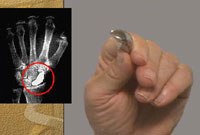Treatments >
Non-Surgical Options
Treatments
>
Surgical Options
Scaphoid Fractures
In a bone graft procedure, pieces of bone are taken
from another portion of the patient’s body, usually the pelvic area,
and are used to fill in the crack that has developed between the
fragments of the broken scaphoid bone.
An alternative surgical procedure involves replacing
the scaphoid bone with a titanium metal implant, which functions in
effect as an artificial bone (see illustration at left).
Carpal Tunnel Syndrome
The surgical procedure for
Carpal Tunnel Syndrome involves opening the volar carpal ligament
(see illustration). Frequently, the portion of the lining
around the nerves and tendons is also removed. This part of the
procedure is called a synovectomy. The objective is to help reduce the
pressure that occurs within the carpal canal and allow more room for
the tendons and median nerve to course through this closed space.
DeQuervain’s Disease
The surgical procedure for
DeQuervain’s Disease involves cutting the thickened ligament
covering the two tendons (see illustration). This surgery
relieves the pressure on those tendons and reduces the wrist’s pain
and soreness.
Other Surgical Options
There are a number of other surgical options
depending upon the injury or illness. With rheumatoid arthritis, for
example, after removing the irritated lining over the swollen,
inflamed joint, a surgical procedure realigns the tendons that have
been distorted and are now out of position. If the joint is
dramatically damaged, an artificial prosthetic joint can be used to
replace the existing joint.
Joint fusion involves removing the joint and filling
the space with a bone graft (see illustration). Bone taken from
another area, usually the pelvic bone, is interposed in the space
between the ends of the remaining bones. This heals in a fixed
position so that the joint is no longer movable, and it is usually
fixed in a functional position. A metal plate or rod is used to hold
the bones in a fixed position.
Although some mobility is possible with joint
replacement, joint fusion severely limits movement of the wrist.
However, in spite of the reduced mobility, the now-stable wrist is
still able to perform almost all of its normal functions without pain.
Remember: good hand function still is possible with little or no wrist
movement, as long as the wrist is pain free.
